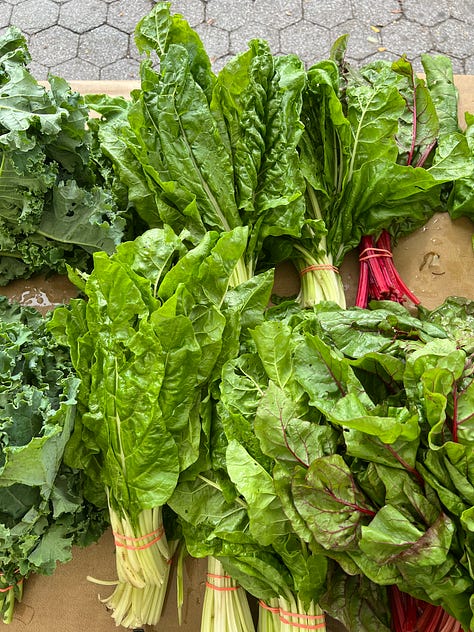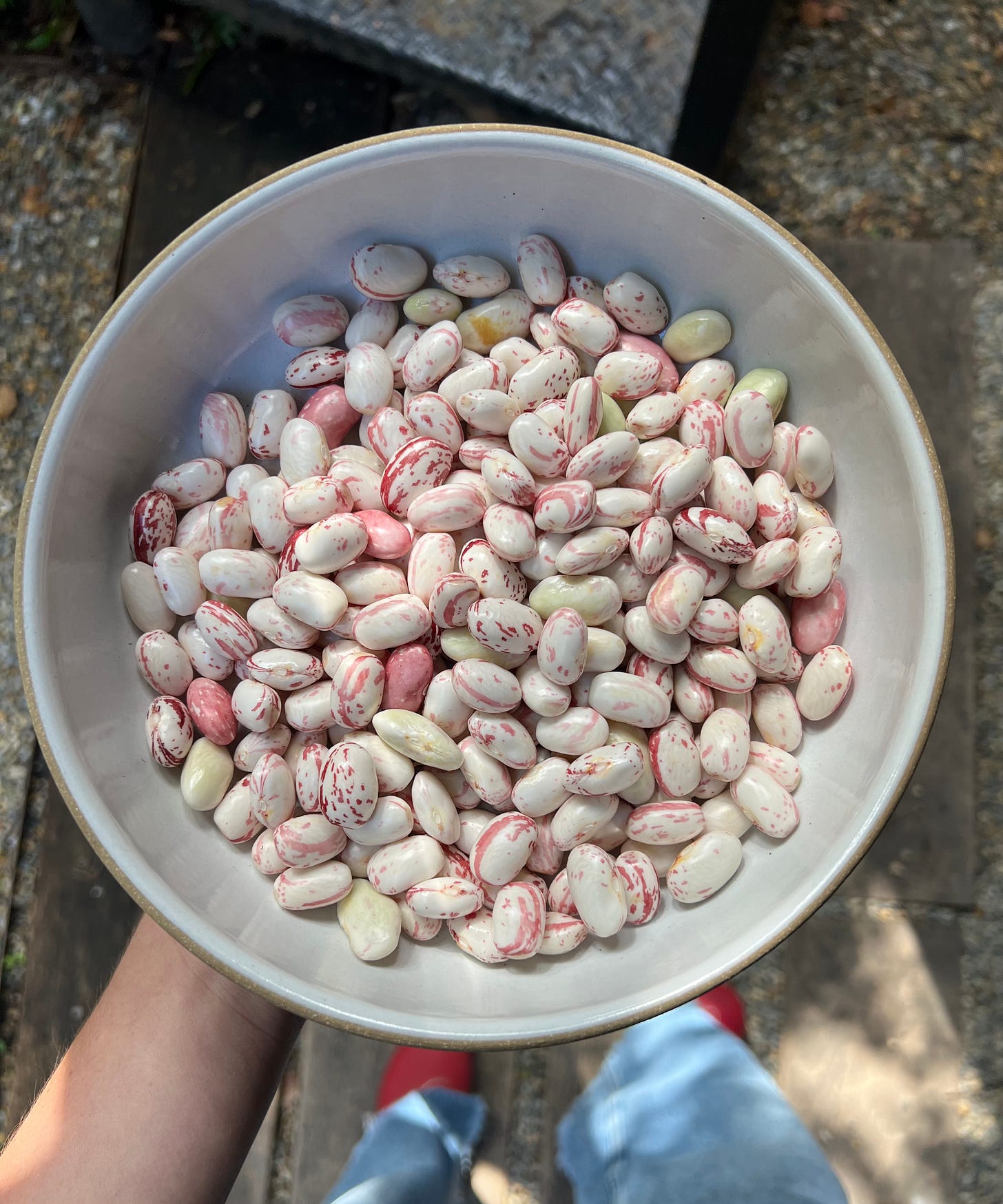I don’t know about you, but when I return from traveling my cooking and eating habits are pretty lame. Since returning from Italy, due to a combination of jet lag, laziness, and some anxious discomfort in the transition from the dolce far niente lifestyle back to freelance career stress, my efforts in the kitchen have been pretty lackluster. Last week I ate lots of sourdough toast with butter and salt, boiled broccoli, soft boiled eggs, pre-steamed beets dressed with vinegar, rotisserie chicken, canned beans and kale simmered in old chicken stock that I found in my freezer, apples and peanut butter, Oreos and milk. I also watched a little too much TV; I caught up on Emily in Paris and watched Chimp Crazy and Nobody Wants This in an embarrassingly short amount of time.



But in the last few days, I’ve found myself excited to cook and think about food again. Over the weekend I made a delicious pasta with sausage, cauliflower, and sage. I cherished one of the last great heirloom tomatoes of the season, made a fresh batch of granola, and started dreaming up menus for a little dinner I’m hosting in a couple weeks. I had a deep desire for a martini and an excellent burger, so thankfully snagged bar seats at Red Hook Tavern. And yesterday I got my no-longer-jet-lagged butt to the Union Square farmer’s market, which early on Monday morning was quiet and beautiful, giving peak, dreamy, sunny New York fall. At the market I was inspired by some vibrant pink cranberry beans and heaping bunches of dandelion greens and Swiss chard. I couldn’t get home fast enough to start cooking them. I shelled the beans, which are perhaps even prettier on the inside, washed the greens, and cooked them both thoughtfully but simply, not imagining that I’d share a recipe with you here. But in my effort to bring my cooking a little more “online”, I shared a picture of last night’s beans and greens, and a few of you asked how to make it. Am I an influencer now?
Clearly not, but a few requests was enough for me, so here you go! It would feel disingenuous to write up a formal recipe for a dish as casual and riff-able as this one, so instead here’s a little walk-through of how one might join in on the beans-and-greens fun:
1. Make a pot of beans. I shelled and cooked fresh beans, because I saw them at the market and it seemed like fun to me, but most of the time when I make a dish like this, the beans are dried, of course. Rancho Gordo beans are excellent, but any dried beans that don’t look too ancient and sad will do. You can soak them in water overnight or even for a few hours to speed up the cooking, but I often forget.
Place your beans in a sturdy pot and cover them with water by a few inches. Season the water with a big pinch of salt and a good glug of olive oil. (In culinary school I was warned to never add salt this early in the bean cooking process, but I’ve since learned that I disagree). Add aromatics to flavor your beans and your broth, depending on what you have around—yesterday I only added bay leaves and a sprig of fresh sage, because I wanted to let the fresh beans speak for themselves. You can also add things like a few smashed garlic cloves or even a halved head of garlic, a halved or sliced onion, half of a lemon, some fresh thyme or rosemary or oregano, a parmesan rind, dried chiles, dried mushrooms, or maybe a piece of something porky like bacon or pancetta. If you’d like to make things even more interesting, before you add the beans and water to the pot, you can brown the aromatics in the olive oil. Choose your own adventure.
Bring the beans to a steady simmer and cook until tender, adding more water as needed to keep the beans just submerged and brothy. My fresh cranberry beans cooked in about 45 minutes. Dried beans can take anywhere from 1 to 3 hours, depending on their size and age. Nearing the hour mark, or 2 hour mark if the beans are larger, begin to taste the beans as they cook, making sure to simmer until they’re all evenly creamy on the inside. All this tasting is also an opportunity to make sure that the beans are well seasoned, so add a little more salt to the broth as needed. When the beans are done, season the broth with a little splash of vinegar.
2. Make the greens. Yesterday I cooked my dandelion greens and Swiss chard in a way that requires an extra step or two, but which I think is well worth it for the richness, flavor, and silky texture it yields. If you’ve ever had sautéed greens in an Italian restaurant and thought “why are these so good?”, they were likely prepared this way.
First, add the greens (stems and all, unless they’re thick and woody like kale) to salted boiling water and cook until tender, 3 to 6 minutes depending on how sturdy they are. Then drain and set them in a colander to cool (or run cold water over them if you’re impatient like me.) Once cool, squeeze the liquid from the greens and give them a coarse chop. Meanwhile, dry out the pot you used to blanch the greens and add a very generous glug of olive oil. Add a few smashed garlic cloves and a pinch of chili flakes to the oil, sauté until the garlic is fragrant and just thinking about turning golden, and then add your greens. Stir to coat, season with salt, and sauté until glossy and delicious, adding more oil as needed. If you want your greens even more tender and silky (which I often do), you can cover the pot and let them simmer for another 15 minutes or so.
This method is also a great way to temper the bitterness/spiciness of greens like dandelion, mustard greens, and broccoli rabe, since a lot of their bitter liquid is lost to the blanching and draining process. To speed this recipe along, you can absolutely skip the boiling step. Instead, you’d just start your oil and garlic in a skillet, and wilt down the raw greens. Or add the raw greens straight to the brothy beans to simmer. The resulting greens won’t be nearly as luscious, but they’ll still taste good.
3. Serve a bowl of the beans with a heap of the greens, topped with a fresh drizzle of olive oil and a bunch of grated parm if you like, with toasty bread alongside. Note: If you make a full pound of beans, you’ll have leftovers, which is a good thing! Think of those beans like beans from a can, but tastier. Leftover beans can end up in a soup or stew, or tossed into pasta, or drained and dressed and added to a salad, or frozen in their broth for a rainy day. Leftover greens are also a blessing, either eaten with the leftover beans or added to a sandwich or an omelet, or eaten cold from the refrigerator, like I did today.
Happy beans and greens season!
xx,
Megan




You're an influencer to meeee! Also: you found dandelion greens in New York?! Teach me your ways
Nothing like warm beans and greans as fall approaches, This has inspired our menu for dinner tonight. I like the part about par cooking the greans to make them tender and silky. I always wonderd how my local Italin deli arrived at that.